
Dave Macleod's latest book Make or Break: Don't let climbing injuries dictate your success is now available to pre-order. Following the success of his first publication - 9 out of 10 climbers make the same mistakes - Dave's newest book is four years in the making and looks set to share some groundbreaking knowledge on injury diagnosis, rehabilitation and prevention that climbers of all ages and abilities would do well to take note of.
We caught up with Dave to find out more about the book and his motivation behind the project.
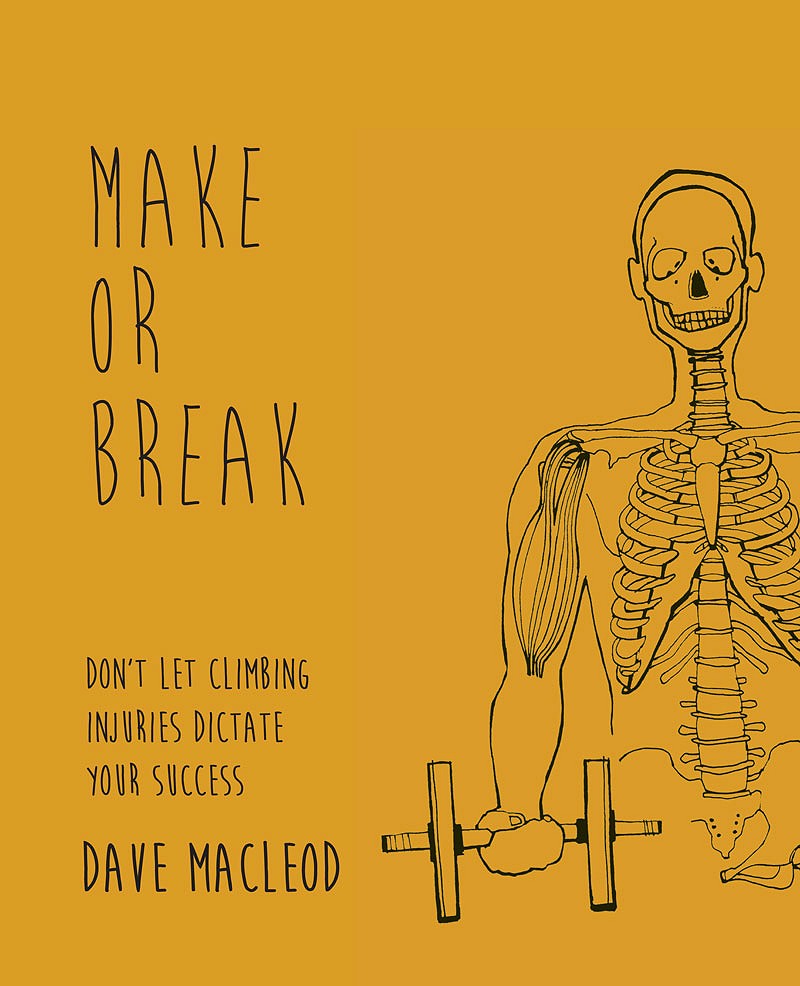
“Getting strong is easy, getting strong without getting injured is hard”- Wolfgang Gullich
NB: Your first book, 9 out of 10 climbers make the same mistakes was very successful and is still a point of reference for many a climber. How does your new book Make or Break: Don't let climbing injuries determine your success follow on from this (if at all)?
DM: Yes - the success of 9 out of 10 has really blown me away. I still get messages most days from climbers who tell me that it has helped them break personal barriers in climbing. That has really spurred me on to get through the work of preparing Make or Break. I wanted to keep 9 out of 10 as a fairly focused book with a clear message about habits and how they determine the effectiveness of your climbing training. But I was obviously aware that injury is just as likely to impact on your longer term progression in climbing as the effectiveness of your training. Since injury is such a big subject, I knew even as I was writing 9 out of 10 that I’d move straight onto writing a dedicated title on climbing injuries.
Make or Break has some similarities with 9 out of 10 in that the early sections go into detail about how our habits unwittingly cause our future injuries and how we can end up failing to seek out the specific knowledge we need either to step off that path to injury, or treat it effectively when it does finally arrive. I also discuss the sports medicine industry and how to get the most out of it, how to read pain signals to prevent and monitor injuries and how to turn the psychological torment of being injured into a rewarding process.
The second half of the book is quite different. It’s basically packed with every piece of evidence-based advice I could find to deal with a good range of the injuries climbers get. I’m pretty sure that a good proportion of climbers will find information in the book that could make a huge difference to their injury outcomes. The research has come on a massive amount over the past decade in all areas of sports medicine, especially the understanding of tendon injuries and healing. I have arranged the book so that those climbers with more complex injury patterns or unusual injuries still ought to be able to gain as much valuable information as possible to help them home in on the tailored recovery program that is right for them.
NB: What prompted you to write a book on climbing injuries?
DM: Basically I want to help other climbers enjoy their climbing. I set out to write the book on how to maintain your body as a lifelong athlete that I wish I’d had when I was 16. I’d certainly have climbed a lot more and harder if I’d had it. Receiving all of the feedback I’ve had from 9 out of 10, I get reminded every day that knowledge I’ve gained the hard way over 20 years can be so effectively spread through the medium of books. Specific and reliable knowledge on how to deal with climbing injuries is very hard to come by. With the internet, there is more poor quality, non-specific and downright dangerous advice that you could ever trawl through. It’s pretty ironic that the information you really need (the high quality scientific research) is largely hidden behind a paywall unless you are part of an academic institution. Other, bigger sports than ours have better systems for disseminating that information via clubs, teams and coaching systems. Climbing doesn’t have that sort of system in place. So the book is a shortcut to getting the key information from the cutting edge of research out to the climbers who are suffering the injuries.
NB: What was the most useful knowledge you took away from your Sports Science studies? Do you think your success in climbing has in part been due to a greater understanding of the way the body reacts to physical training?
DM: There’s no doubt that my study in sports science has helped me immensely. One of the major points I made in 9 out of 10 was that getting bogged down in the details and deep corners of training science is a really common pitfall among amateur athletes and even many coaches. A thorough grounding in the sciences that underpin sports science helps you to stand back and see the bigger picture of the full range of aspects that hold back climbers' performance. This perspective has definitely helped me break barriers in climbing that I previously felt would be beyond me. I’ve never been a strong climber, partly because I don’t respond that strongly to training and partly because I’ve always been too busy out scrubbing new routes or scratching about on ice to do enough training to get strong. But I have been able to see what other weaknesses I could work on that would make up for that. I reckon I must be a contender for the weakest climber ever to have slapped up Font 8B+. I feel pretty happy about that - In my early twenties I thought Font 8a would my lifetime limit.
My masters was on both medicine and science in sport and exercise and it started me on the journey to thinking along the same lines about dealing with injuries. On one hand, I knew if I simply wrote a book that had the specific facts about what to do to rehabilitate the common climbing injuries, that alone could make a big difference, since so much of that knowledge is still pretty hard to find online or even from many therapists. Unfortunately, these simple pieces of information are only a fraction of what self-coached climbers need to learn. Injury prevention comes from so many different strands - the subtleties of movement technique, the planning and progression of your training activities, posture and alignment, nutrition, recovery quality, rock shoe choice, warm-up, social environment in climbing, stress levels and many more besides. Most sports medicine textbooks don’t even cover all of these elements and there is nothing out there for climbers that covers the climbing specific skills.
NB: What was your first injury and how did you deal with it?
DM: My first real injury was an A2 pulley tear in a finger at age 16. The idea of injuries didn’t even cross my mind until I suddenly couldn’t climb because of pain. I didn’t understand it at all. As far as I was concerned, injuries were something that happened to old climbers. I went to my GP who told me to take 6 weeks of complete rest and ibuprofen. It makes me mad to hear this advice is still regularly given out 20 years on, even though the concept of progressive loading is well accepted as the most successful strategy to improve tendon and ligament healing. After the 6 weeks I went back to tell him there was no noticeable progress. He just told me to try a different sport! I’ll never forget walking away from the clinic that day. It was basically a defining moment in my life. I realised that the only way way I was going to recover from the injury would be to become as expert as I possibly could. The only way I could access sports medicine textbooks at that time was by huddling away in university bookshops for hours and reading what I could. That experience of learning the specific knowledge I needed straight from the scientific sources was one of the reasons I eventually decided to study sport and exercise science.
In the sports medicine textbooks I learned how much work you have to put into careful repetitive loading of injured ligaments and tendons. I worked away every day doing that and in the end, when I returned to climbing I was stronger on the first day back than before I got injured and did my first Font 7b. It really spurred me on.
NB: What has been your most challenging injury and why?
DM: My list of injuries is quite impressive and some are obviously a lot easier to recover from than others. The worst has definitely been a cartilage tear in my right ankle after being lowered off the end of a rope in 2012. I’m off to Germany soon for my second surgery on that ankle and I’ve accepted it will never be the same again. Since cartilage basically doesn’t heal in adults, they are some of the most serious sports injuries you can get. It's been a tough journey with some real low points. I am constantly learning to work around the injury and change everything about how I use the ankle. I have to concentrate just to walk down the stairs now. But thankfully it affects my rock climbing a lot less than if I were a runner. I’m basically bloody lucky to be alive after somersaulting down a 6b+, hitting a ledge and wrapping myself round a birch tree. I’ve climbed 8c sport, 8B+ boulders and 8b+ on an alpine north face since then so I’m doing ok. I’ve certainly realised that you can do a lot even with some quite big functional problems with your body.

NB: How long did the process of research and writing take you, and how do you fit it in with your climbing trips?
DM: The process of writing it was quite exhausting for me. I could have managed the book alone, but mixing it with trying to climb and doing all the other things in life was difficult. I started it in 2010 and worked on it intermittently ever since. I did sort of leave it aside at various points, but it was talking to injured climbers that kept me going back to finish it.
NB: What do you hope that readers will gain from your book?
DM: I hope as a minimum, readers will understand clearly what their role is in looking after their body which they wish to push to its limits through youth and into old age. I hope they will see clearly the limitations of the sports medicine industry and take the steps they need to make sure they get the very best advice and treatment available, or at least be aware of the consequences of leaving it to chance.
In many cases, I think people will read some pretty simple stuff that will make all the difference. For example, the detail of how to do the physio exercises to recover from golfer’s and tennis elbow. You need to know a small series of crucial facts to get the rehab right. If you do them slightly wrong, you could suffer with the condition indefinitely. If you get it right, you could recover completely in a handful of weeks in some cases.
“For every complex problem, there is an answer which is clear, simple and wrong” - H.L. Mencken
NB: Diagnosis, rehabilitation and prevention are key concepts mentioned in your discussion of injuries - why do think there has been so little information out there for climbers previously?
DM: There is more and more information available for climbers all the time. But there are various problems with it. Firstly, the best source of advice, the good quality scientific research, remains inaccessible for most people. Unless you are part of an academic institution it can be tricky to get hold of relevant research papers. Secondly, there is a huge amount of inertia in getting the findings at the cutting edge of the research into practice. Unless you already have a lot of sports medicine knowledge, it can be extremely difficult to judge the quality of advice, or whether it is actually relevant to you. Thirdly, it’s amazing just how much poor quality advice there is, both on public forums, where you might expect to find it, but also in articles from therapists or coaches. In short, it’s a complete minefield. I open the book with a quote from H. L. Mencken: “For every complex problem, there is an answer which is clear, simple and wrong”. This quote comes to mind a lot when reading about sports injuries online.
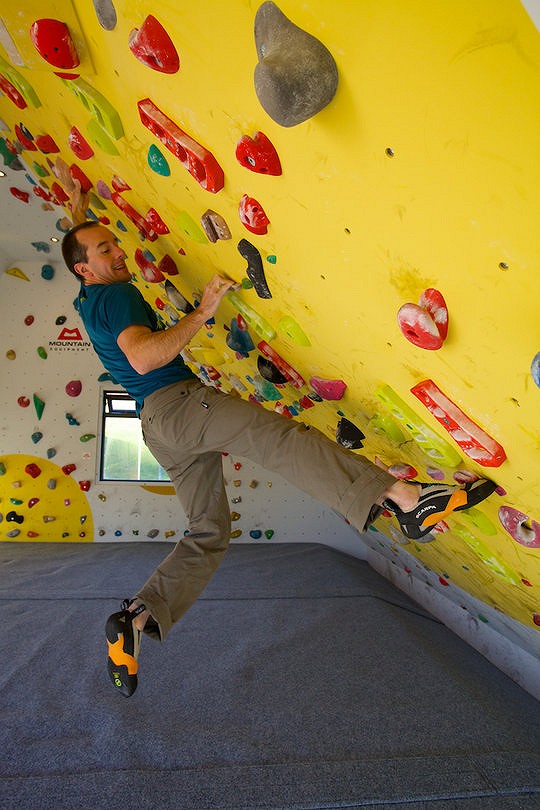
I hope climbers take from my book the need to be rigorous in diagnosing their injuries properly from the outset, with at least one examination from the best experts they can find, and ideally with scanning where the examination doesn’t provide a definitive answer. I encourage climbers to constantly push for the most thorough approach, rather than the minimum, which is sometimes what you are offered from medical staff. Once you have the diagnosis, you can get down to the real work of planning and executing a tailored rehab program. So many climbers fail to progress because they just don’t seek out the advice, or once they have it they just don’t do all physiotherapy exercises. This is a big problem and I’ve given some ideas of my own to make the rehab process a lot less daunting and more enjoyable.
Finally, there is prevention. Having thought about injuries so much over the past 4 years, not to mention having dealt with my own, I do feel for young climbers when I see them in the climbing wall or coach them. Who wants to think about injuries when you are young and feel strong and just want to train harder? The idea of injury prevention is always going to be a hard sell. I’m sure that some of them will just keep going without giving a thought to prevention until something hurts. But I do make a direct appeal in the book to young climbers and their parents and coaches, that thinking about these things will not only save them anguish in the future, but will probably help them climb better now. There is a whole chapter for young climbers. Youngsters particularly need to be aware of epiphyseal (growth plate) fractures in the fingers. They can be a career-ender if not caught early enough. This injury was unheard of until the explosion of youth competitions and climbing centres a decade or so ago.
NB: You mention 'habits' fairly frequently, do you think climbers as a community get drawn into routine more so than in other sports?
DM: No, it’s more that poor habits in training or injury avoidance are a huge problem across sport. Moreover, in some ways the problem is getting even worse at the moment. There are personal habits and wider fashions in sport. Climbers are well used to borrowing information from other sports about training. This borrowed information can be advantageous in some ways. Because you have to adapt the knowledge to fit climbing, it encourages you to think a little more critically. But this sort of critical thinking still doesn’t happen nearly enough. A good example of this is the recent fashions for body strength exercises in climbing. Now, this is a really good development!
However, although you can watch videos of many different exercises and buy books listing exercises, there is little information for the individual to choose which exercises to do, based on their specific weaknesses. There is also a tendency for fashions such as this to overrate the importance of a given type of training which the community is particularly excited about at a given moment. So some climbers might replace good chunks of their normal training time doing sling training or box jumps, at the expense of training their technique or finger strength. Seeing your personal performance weaknesses clearly will always remain the tricky step that determines how much real improvement climbers will yield from their training.
The same goes for injury related choices. You may find that your massage therapist really helps an injury you have feel much better and allows you to train. The treatment feels good, it allows you to train and the effect is immediate. So the appeal is built right into the product. But it may or may not be the right choice. It may be that it has a role only as a facilitator, and it is actually the extra training you can do that is causing any real healing of an injury. Or, it may not be helping the injury heal at all. It may be merely affecting pain, with no healing and therefore no progress; as soon as you stop the treatment, you are back at square one. It’s critical to look at the underlying causes of the injury and remove them. This is no easy task and in many cases climbers will need professional advice from a good climbing coach, orthopaedic consultant and physiotherapist to get a clear idea.
In the book I have provided many possible causes of common climbing injuries, so at least you know where to begin your search for the answer. Seeing all these professionals might seem like a daunting prospect, and maybe an expensive one. It’s true that you have to put some real effort in to make progress with injuries, there is no way around that. It may cost a bit too, but so many people spend large amounts on regular therapy sessions that are only treating symptoms, or on nutritional supplements that may be of no benefit. Take Glucosamine Sulphate for example; It is a billion dollar industry despite a large review of the research into its use failing to show any therapeutic effects.
For more information and to pre-order Make or Break, visit Dave's online shop here.













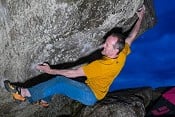



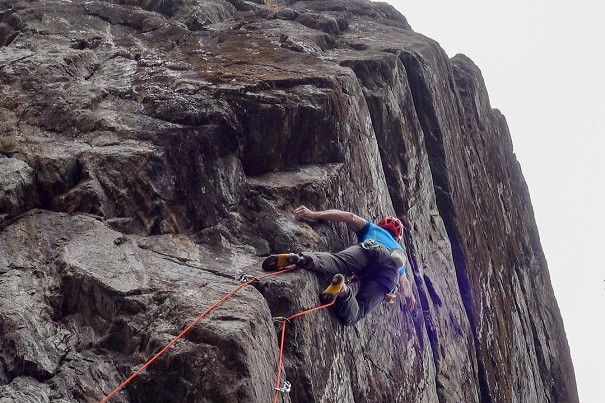
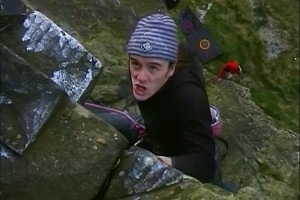
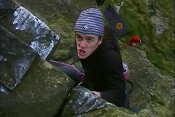
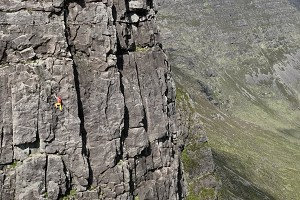
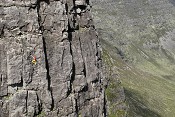
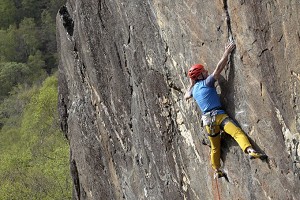
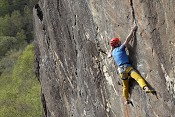

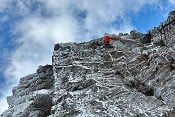

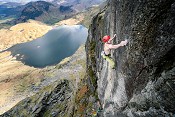
Comments